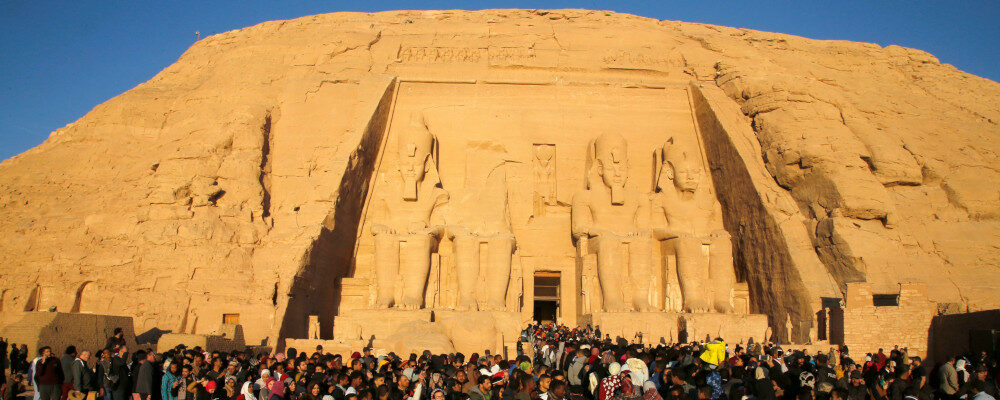“I am great OZYMANDIAS,” saith the stone,
The King of Kings; this mighty City shows
The wonders of my hand.” — The City’s gone, —
If this sounds almost familiar, it’s because it’s from the poem “Ozymandias.” But not that “Ozymandias.” This version was written by Horace Smith as part of a competition with his friend Shelley to compose sonnets on a common theme, in this case a passage from Diodorus Siculus’s Bibliotheca historica. (These competitions were a productive pastime for the Romantics: Percy’s wife Mary wrote the novel Frankenstein as part of a similar contest with Lord Byron while the Shelleys were staying nearby on Lake Geneva during the dreary non-summer of 1816.)
Shelley’s and Smith’s sonnets both describe a broken colossus crumbling in the desert above slightly different paraphrases of the inscription that Diodorus Siculus records as “King of Kings am I, Osymandyas. If anyone would know how great I am and where I lie, let him surpass one of my works.” Both poems are parables about the impermanence of worldly renown, and Shelley’s version, with its mawkishly didactic lesson about pride and hubris, is a staple of the high school English curriculum.
The moral is artistically effective and the message memorable, but they are false. No matter how much Shelley tries to convince us that the works of great men are ultimately in vain, his poem’s very existence belies its intent. The truth, inescapable, is that the works of Ozymandias—or Rameses II, as he is better known—do endure, and not just in Shelley’s well-known (and Smith’s less well-known) poem. They can be found from the Nile Delta to Abu Simbel, and we still stand before them in awe. Look on his works ye mighty, or ye average Joe, and despair.
I was reminded of Shelley’s poem in the Pergamonmuseum in Berlin last year, as I read the mortuary epitaph of the neo-Hittite King Panamuwa I. Carved on a colossal statue of the Hittite storm-god Hadad, the long inscription begins, with echoes of Diodorus Siculus:
I am Panamuwa, son of Qarli, king of Y’DY, who have erected this statue for Hadad in my eternal abode. The gods Hadad and El and Rašap and Rākib-El and Šamaš supported me. Hadad and El and Rākib-El and Šamaš and Rašap gave the scepter of dominion into my hands. Rašap supported me. So whatever I grasped with my hand […] and whatever I asked from the gods, they granted to me.
Reading it, I was struck by just how wrong Shelley was. There, standing in the grand centre of the capital of a country whose power and wealth he could not have imagined, on display to visitors from around the world, was a statue erected by a regional warlord to his immortal memory. Three millennia later, and three thousand miles from where he died, millions of people have read of King Panamuwa’s feats and marvelled at his monument. So much for the tragic evanescence of worldly fame.
Shelley and Smith appear to have understood the weakness of their artifice, as both poets altered their source material to make their points. In Diodorus Siculus’s account, the statue is not “a colossal wreck” and there are no “vast and trunkless legs of stone” (or, in Smith’s version, “a gigantic Leg”). He describes the figure as “seated … the largest of any in Egypt” and “marvellous by reason of its artistic quality and excellent because of the nature of the stone, since in a block of so great a size there is not a single crack or blemish to be seen.” The implication is clear: the greatness of Osymandyas is well-attested by his surviving monument.

Nor could the poets avoid the awkward fact that they were writing a poem about the fleeting memory of a pharaoh they knew by name. The fictional Ozymandias may be a forgotten titan, but the real Rameses II is probably the only pharaoh most people can name, other than the comparatively inconsequential boy King Tutankhamen. Shelley may not have lived to see him portrayed in Technicolor by Yul Brynner or in sadistic prose by Norman Mailer, but even he was excited enough about the arrival of one of his surviving sculptures in London in 1818 to be inspired to poetic competition.
It was a perverse conceit to compose a meditation on ephemeral repute based on an example of enduring renown. Poets may be, as Shelley once boasted, “the unacknowledged legislators of the world,” but the greatest of actual legislators are also acknowledged in their lifetimes and remembered long after. This may be, in part, thanks to the work of poets and other artists, as Shelley implies when he praises the skill of Ozymandias’s anonymous sculptor. But artistic subjects are chosen for a reason, and in this case crediting the artist for his subject’s enduring memory means forgetting who was in the position to commission whom.




